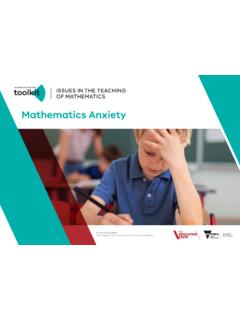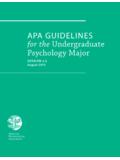Transcription of The Sum of All Fears: The Effects of Math Anxiety on ... - ed
1 Jump to Article:The Sum of All Fears: The Effects of Math Anxiety on Math Achievement in Fifth Grade Students and the Implications for School CounselorsSarah E. Ruff and Dr. Susan R. Boes, The University of West GeorgiaSince President John F . Kennedy challenged congress in May of 1961 to be the first country to put a man on the moon, the United States has worked to reform education and increase achievement to keep up with the achievement displayed by students in other countries . Even after winning the race to the moon in 1969, the United States continues to struggle to match its international counterparts in mathematic achievement . In 2009, The Program for International Student Assessment (PISA) performed a cross-country comparison on the performance of 15 year-old students in reading, mathematics and science.
2 American students scored below the international average in mathematic literacy . Among 33 industrialized countries, 17 countries had higher average scores than students, five countries had lower average scores, and 11 countries had scores that were not statistically different from American students (National Center for Educational Statistics (NCES), 2011) . In 2012, the National Assessment of Educational Progress (NAEP), group provided a snapshot of the condition of education in the United States based on results from its 2011 national study . Students in 4th, 8th, and 12th grade were assessed in reading, mathematics, and social studies . Eighty two percent of the elementary students assessed reached only partial mastery of math knowledge and skills fundamental for proficient work at the 4th grade level.
3 In addition to the national implications from the results, there are also local implications as a comparison was made amongst the 50 states and the District of Columbia . The results indicated that 4th grade students from 33 other states scored higher in math literacy than 4th grade students in Georgia, students from 15 states scored lower and two states, Arkansas and New York, scored the same as Georgia students (NCES, 2012) . Despite the continued education reform and political efforts over the past decades, the math achievement gap has not closed .Numerous research studies have been conducted to pin-point the reasons for the gaps in mathematic achievement for American students.
4 The causes are wide ranging. It is difficult to single out a particular cause for low achievement for American students, but a persistent theme is math Anxiety . The negative Effects of math Anxiety on achievement are extensive . Geist (2010) suggests that for many children math achievement is not related to potential level but rather to their fear of and/or negative attitudes toward math . Math Anxiety is more than a barrier to math achievement as it has a widespread impact on other aspects of students lives . Seen as early as kindergarten, math Anxiety can impede initial learning which results in poor math skills and negatively affect long-term academic success and career choices (Ashcraft, 2002; & Wu, Barth, Amin, Malcame, & Menon, 2012).
5 Highly math anxious students tend to avoid math in general; Anxiety prevents completion of small tasks as homework or paying a restaurant bill and large ones like excluding math and science related career path options (Beilock, Gunderson, Ramirez, & Levine, 2010) . Math Anxiety is more than nervousness before a math test; it has pervasive negative impacts on math learning, everyday life, and career choices . This Action Research Study (ARS) reviewed the literature related to math Anxiety in children . Current interventions to reduce math Anxiety are presented . Additionally, gaps in the literature and action research related to school counseling interventions for math Anxiety for elementary students also are addressed.
6 Literature ReviewSince long-term negative impacts of math Anxiety begins as early as kindergarten (Ashcraft, 2001) this literature review focuses on early onset in children and proposes interventions to reverse harmful Effects . Children are defined as elementary school-age students . To identify relevant scholarly peer-reviewed literature, the parameters were set to research definitions, causes, and interventions for math Anxiety related to elementary students . AbstractLow math achievement is a recurring weakness in many students . Math Anxiety is a persistent and significant theme to math avoidance and low achievement . Causes for math Anxiety include social, cognitive, and academic factors.
7 Interventions to reduce math Anxiety are limited as they exclude the expert skills of professional school counselors to help overcome this nervousness . The effectiveness of a school counseling small group intervention to reduce math Anxiety and increase achievement in fifth grade participants is presented. Jump to Article:Definitions of Math AnxietyFor decades, the subject of math has been plagued with fear and Anxiety by some students . As early as the 1950 s, educators and researchers began to recognize the significance and prevalence of students with fears and negative attitudes toward math. Studies emerged trying to identify and define this phenomenon . After observing students struggle with math, Gough (1954) described her students fear and avoidance of math as a disease and called for interventions to help these students.
8 Dreger and Aiken (1957) described number Anxiety as negative emotional responses to mathematics . Richardson and Suinn (1972) defined math Anxiety as stress causing negative physical reactions that interfere with the manipulation of numbers and problem solving in both academic settings and everyday life . Additional studies from the 1970 s to present day used these definitions or similar ones for math Anxiety . All definitions include an extreme negative physical, emotional, and cognitive reaction to math that hinders a person s ability to learn and perform math activities (Ashcraft, 2002; Beilock, et al ., 2009; Henry & Chiu, 1990; Mattarella-Micke, Mateo, Kozak, Foster, & Beilock, 2011; Tobias, 1978).
9 For this ARS, math Anxiety is defined as an intense fear, nervousness, and dread related to math leading to avoidance of mathematic activities and impedes math learning (Ashcraft, 2002) .Causes for Math Anxiety The literature discussing causes and/or contributing factors for the prevalence of math Anxiety in elementary students involves various social, cognitive, and academic elements . Social factors include continued race and gender stigmas and lack of parental support in low socioeconomic (SES) households . Cognitive factors comprise dyscalculia and deficits in working memory . Academic factors encompass the traditional math curriculum used in classrooms, ineffective teaching styles, and the influence of math anxious teachers.
10 Social factors. Gillen-O Neel, Ruble, & Fuligini, (2011) found students aware of negative subgroup stigmas are more likely to exhibit Anxiety , poor self-esteem, and lack motivation . Several studies attribute elevated math Anxiety and low math achievement in females to the enduring stereotype, that Girls are not good at math (Beilock et al ., 2010; Geist, 2010, Sparks, 2011; Tobias, 1978 ) . Sparks (2011) reviewed studies confirming that regardless of math ability, girls are more likely to have higher math Anxiety and lower math achievement than boys . The perpetuation of stereotypes also increases math Anxiety and poor self-esteem in other minorities . Renya (2000) revealed that ethnic minorities are more apt to lose motivation and interest in math when stereotyped as low achievers.













